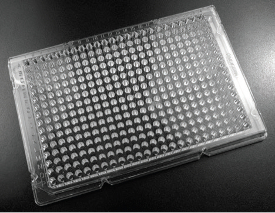Featured Article

Please see our Microplate Instrumentation section to find manufacturers that sell these products
Microplates, also known as microwell plates, are widely used in molecular biology, clinical and analytical workflows. Multiwell microplates are a staple for performing enzyme-linked immunosorbent assays (ELISAs). As a result of improvements in plastics technology, today’s microplates have improved strength, temperature stability, size, fit, volume precision and optical properties. Microplates are typically made of polypropylene, although different polymers and glass are sometimes used. The different types of plastic work best with specific detection modes, as shown in Table 1.
Table 1 – Modes of detection and types of plastic

Their ability to handle a wide range of temperatures is one of the reasons microplates can be utilized in a variety of analytical instruments. Those that are not disposable can be washed with specialty microplate washer equipment.
Some low-density microplates feature 6–24 wells. The most common format is 96 and 384 wells (see Figure 1). Certain high-throughput screening methods allow for the use of microplates with 1536 or 3456 wells.
How to choose a microplate
 Figure 1 – Evergreen Scientific’s (Los Angeles, Calif.) 384-well nonsterile clear polystyrene microplate for general-purpose use.
Figure 1 – Evergreen Scientific’s (Los Angeles, Calif.) 384-well nonsterile clear polystyrene microplate for general-purpose use.Instrument manufacturers have made choosing a microplate detector as simple as narrowing down the application. The user must consider the state and exposure of the assay in the detector. For example, will live cells be examined? Will the sample be immersed in a control? What kind of solvent will be used, and will the material of the microplate withstand exposure? What type of exposure is being utilized during detection? How many samples will be analyzed in one run, and what are their volumes? These factors will impact the choice of substrate material, color, transparency and size of the microplate.
The shape of the wells impacts the sample testing capacity. V-bottom microplates have wells with tapered bottoms, making them ideal for pipetting the sample volume. Promega (Madison, Wis.) offers V-bottom deep-well square microplates for use with its Genetic Identity Automation Hardware line. Round- or U-bottom microplates are useful for agglutination tests and storage. PerkinElmer’s (Waltham, Mass.) StorPlate-96U is designed to handle temperatures to –80 °C, making it suitable for drug discovery.
F- or flat-bottom wells are frequently used in optical detection (e.g., absorbance). The well shape does not skew the flow of light for optical measurements. Transparent F-bottom Greiner 96-well plates from Sigma-Aldrich (St. Louis, Mo.) are effective for analyzing the growth of cell cultures.
For storage and safety, many microplates have covers. BrandTech Scientific, Inc. (Essex, Ct.) offers polystyrene well plate lids for BRANDplates, allowing for stacking.
Emilia Raszkiewicz is managing editor, American Laboratory; [email protected]
Please see our Microplate Instrumentation section to find manufacturers that sell these products